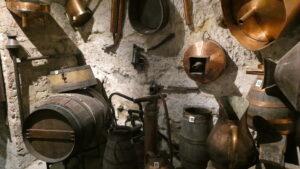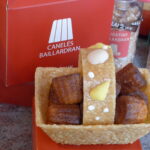 The most impressive hall of ‘Paris Expo Porte de Versailles‘ is hall six. It’s desiged by the architect Jean Nouvel. He also designed Musée Quai Branly Paris (for ethnographical art). In front of hall six he made and eccentric mobile louver with moving text on it. Jean Nouvel is 77 years of age and he is well known all over the world. There are seven halls with a capacity of 215000 square meter.
The most impressive hall of ‘Paris Expo Porte de Versailles‘ is hall six. It’s desiged by the architect Jean Nouvel. He also designed Musée Quai Branly Paris (for ethnographical art). In front of hall six he made and eccentric mobile louver with moving text on it. Jean Nouvel is 77 years of age and he is well known all over the world. There are seven halls with a capacity of 215000 square meter.
Six were used for WineParis and Vinexpo Paris. The next fair is from the 12th till the 14th of February 2024.
Because I have a sweet tooth I found the stand outside of ‘canelé de Bordeaux’.
A canelé is a small French pastry flavoured with rum and vanilla with a soft and tender custard center and a dark, thick caramelized crust (defenition I found on the internet).
It’s one of my favorite French pastries. And I love sweet, homemade things.
But there is certainly more to see in Paris…. You can go to a museum to learn more about art or an object, a culture, or history.
The museum of wine ‘Le Musée du Vin Paris‘, is not very big but worthwile visiting. It’s situated in an  old chalk mine on 5 Square, Charles Dickens. Between the 13th and 18th century the chalk mine was used to build buildings and houses in the city of Paris. The chalk was found between 37 and 80 meter below see level. The galleries of the museum of wine are hollowed out in the lower geological layers.
old chalk mine on 5 Square, Charles Dickens. Between the 13th and 18th century the chalk mine was used to build buildings and houses in the city of Paris. The chalk was found between 37 and 80 meter below see level. The galleries of the museum of wine are hollowed out in the lower geological layers.
Three rooms are reserved for the restaurant. In the 16th and 17th century these rooms were used by monks or friars. The monks were able to produce a nice ‘Clairet’. A ‘Clairet’ is something in between a rose and and a red wine. They could make this wine because there where vineyards nearby. In the 19th century the walls of the mine were consolidated.
 After 1950 the cellars were used to store wine for the restaurant in the ‘Eiffel Tower’.
After 1950 the cellars were used to store wine for the restaurant in the ‘Eiffel Tower’.
In between the mine was owned by the conseil ‘Echansons de France’. This is a confrérie or union in English. It’s goal is to promote the best wine appellations of France. In the ‘Musée du Vin’ you can visit of course the museum, get something to eat in the restaurant and have a professionel wine tasting. The manager of the museum is Claude Josse, a man who I met years ago when I was invited in Avignon for a wine-trip. The one time I also met Pierre Cardin, https://www.museeduvinparis.com.
On 116 Bd Haussmann (8th district), there’s the oldest wine shop of Paris. It’s from 1850. It’s a
valhalla for wine lovers. In the shop they have about 5000 references from wineries and spirit companies. In the building there’s still an old elevator to go down stairs with a harmonica door.
I would have loved to stay longer in this shop!

On the same boulevard, on number 97, there’s the bistro of the famous sommelier Philippe Faure-Brac. In 1988 he was elected best sommelier of France and in 1992 he became the best sommelier in the world (In Rio de Janeiro). Since 2015 he was awarded M.O.F. Honoris Causa. In France a M.O.F. means ‘Meilleur Ouvrier de France‘. In English it’s
He also wrote several books about wine and he is a radio- and television host. Philippe Faure-Brac is born in Marseille on the 25th February 1960.
https://bistrodusommelier.eu
On the 14th of February we had the pleasure to dine in his restaurant.
And off we go to an exciting new wine or food adventure……






















Dag Jirka, wat is dit weer een prachtig verhaal vol info over wijn en bijzondere plaatsen!
Ik had nog nooit gehoord van “Le Musée du Vin Praris”. Zelfs wanneer je geen wijnfanaat 😉bent
lijkt het me super interessant om het te bezoeken. Maar liefs met ruimtes op 80 meter onder het waterpeil op de bodem van n kalkgrot. Uniek!
En… dat toetje wil ik, na wat jij er over schrijft, echt ook wel proeven …